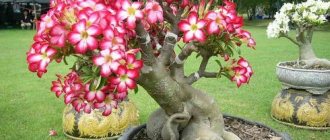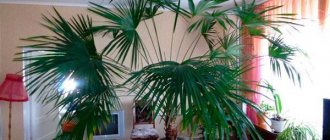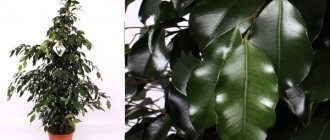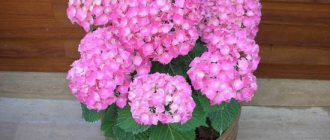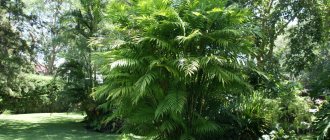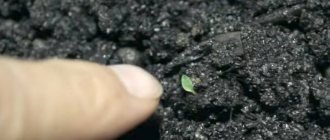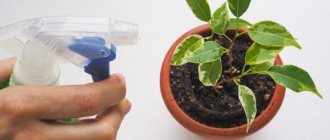Hamedorea, or bamboo palm, is a robust, beautiful plant with bright green foliage. A native of the tropics decorates any living space, as well as the interiors of offices and schools. Wild crops are found in South and Central America, in Mexico. A mature tree can reach a height of 2 meters.
Growing an exotic beauty at home is popular and has its own development characteristics. Very often, signs of disease appear or chamedorea leaves become discolored; in such a situation, you need to know what the cause is and how to cope with the problem.
Chamaedorea indoors
Diseases and pests
Some problems may arise during cultivation:
- Dry tips of chamedorea leaves are a sign of dry air. It is necessary to regularly ventilate the room and spray the palm tree.
- Leaves turn yellow - too much light or watering with hard water. The plant should be moved to a darker place and soft water should be used.
- The leaves droop, die, and rot - this usually happens in winter due to rotting of the roots of the palm tree. The reason for this is excessive watering of the plant. To correct the situation, you need to reduce the frequency and volume of watering and loosen the soil. You can replant by cutting off the rotten roots, and adding drainage and moisture-retaining components (sphagnum or coal) to the soil.
- Brown spots on the leaves are a sign of overwatering the palm tree or using too hard water. It is necessary to cut off damaged leaves, reduce watering, and use soft water.
- The leaves wither and darken - the consequences of keeping them at low temperatures. You need to move the plant to a warmer room.
- The lower leaves fall off - this is a normal process for aging palm leaves. Such leaves are cut and the cut areas are treated.
- A cotton-like coating on the leaves is a sign of a mealybug appearing on the plant. The bush will need to be treated with insecticides.
Pests that can attack: mealybug, spider mite, scale insect.
Choosing the right chamedorea when purchasing
When purchasing a plant, it is important to inspect it carefully to ensure there are no defects. There should be no broken branches or irregularly shaped leaves. Dull or yellowish color is unacceptable. A limp appearance may indicate root rot, which is a common problem for palm trees.
When purchasing, check the leaves to make sure they are free of pests. If there are small brown or green spots on the trunk, you may suspect spider mites. If you buy such a specimen, you will have to put a lot of effort into pest control.
Hamedorea pests and diseases
Among the pests, Neantha can be affected by spider mites, aphids, scale insects and mealybugs. The bamboo palm is resistant to harmful insects, but dry air and contaminated soil can lead to their appearance
If the leaves of Hamedorea begin to turn yellow and dry, carefully examine them from the underside, and also pay attention to the trunk:
- spider mites can be recognized by very small moving dots and cobwebs between the leaves;
- scale insects look like gray or brown plaques that are difficult to tear off;
- green or gray aphid insects can settle on the table and the top of the tree;
- Mealybugs look like pieces of cotton wool.
All these insects feed on the sap of the plant, which is why the leaves first lose their decorative appearance, and soon dry out and fly off. Pests can be destroyed using special insecticidal preparations.
When the soil in the pot stagnates, the air in the room is cold, and the soil is contaminated, chamedorea can be affected by diseases in the form of pink rot or leaf spot:
- Pink rot
affects the roots of the palm tree, and wet pink, brown or brown spots appear on the leaves and trunk. After some time, the trunk rots and the plant dies. To cure chamedorrhea, you need to change the soil, trim off the rotten roots, and treat the remaining ones with a fungicide. - Leaf spot
is a fungal disease that appears as oval or round spots on leaves that are gray, brown, light green, brown, white or yellow. The fungus multiplies quickly and soon the leaves wither completely. It is necessary to reduce watering, trim off affected leaves and spray the bush with a fungicidal preparation.
Hamedorea transplant
Palm trees should be replanted towards the end of spring. A sign is that the container is completely filled with roots. Since chamedorea feels quite comfortable in a small container, it is better not to disturb mature trees with this procedure. Replant large trees as necessary (the tub has rotted, pests have appeared in the soil).
Transplant methods
There are two ways to transplant a flower - complete transplantation and transshipment.
When completely replanted, the palm tree is removed from the container, the root system is cleared of the previous lump, and rotten roots are removed. If necessary, the shoots are separated. Freshly prepared soil or Palma soil is poured into the pot on top of the drainage.
However, the plant will more easily tolerate such a method of transplantation as transshipment , in which the tree, along with a clod of soil, is simply transferred to a large container, and the free space is filled with fresh soil.
In any case, a drainage layer (expanded clay, small pebbles) is formed at the bottom of the dish. It is necessary for the drainage of excess moisture and for the penetration of oxygen necessary for the roots.
How to fix the problem
Hamedorrhea, the leaf diseases of which can be seen in the photo, is very rarely subject to infections. The cause of the disease is improper care. To eliminate the problem, it is worth trimming the shriveled leaves, trimming the damaged tips and providing the plant with partial shade, humidity and a stable temperature.
If the cause of yellowness is waterlogging of the soil, and rotting of the root system is detected, there is only one way out - replanting the plant, during which all damaged parts are cut off.
Systemic insecticides - Fitoverm, Vertimek, Actellik - will help cope with insects. They are used several times with an interval of 10-14 days. But chemicals won’t help you deal with scale insects. They fight it only mechanically: using a toothbrush, remove insects from leaves and shoots. You can also use a cotton swab soaked in alcohol.
When fungal diseases occur, complex fungicides are used.
Feeding the plant should also be regulated, since an excess of potassium leads to yellowness. It is recommended to alternate organic and mineral preparations.
Hamedorea is a heat-loving palm tree. She reacts painfully to sudden changes in temperature or to watering with cold water. Exot needs spraying and showering in hot summers and does not tolerate waterlogging in the winter. Loves nutritious organic matter and is afraid of drafts. By providing chamedorea with such conditions, you don’t have to worry about its diseases - a strong plant will cope with troubles on its own.
Appearance of spots
Hamedorea has excellent immunity, and therefore very rarely suffers from disease. But sometimes owners of chamedorea complain of a spotty coating at the base of the leaves coupled with dryness, blaming pests for this. The reason lies in the incorrect irrigation system. It should be plentiful and not too frequent. Excess moisture can cause rotting of the root system, causing the leaves to dry out. Ordinary running water is harmful to palm trees; only filtered water without impurities will do. In winter, you need to water your palm tree less than in summer.
Is it possible to save a plant that has already suffered from excessive watering and what needs to be done:
- remove the tree from the tub and wipe its rhizome with a solution of potassium permanganate;
- replant in new, loose soil, after placing drainage at the bottom of the pot.
Leaf tips dry out due to water quality
Tap water is not suitable for watering indoor plants.
Water for irrigation should not contain alkali, acids or toxic compounds. Tap water can burn the root system of some plants, such as spathiphyllum, chlorophytum. It is categorically not recommended to water them with water taken from the city water supply.
For them, you can use melt water, rain water or settled water. Even purifying tap water with activated carbon tablets will not bring the desired result. When interacting with sorbents, fluorine and chlorine disappear, but the sorbent cannot remove impurities of calcium and salts. A compromise solution for watering indoor plants is distilled water.
Caring for chamedorrhea at home
To grow an overseas beauty at home, you don’t have to spend a lot of time and effort.
By providing it with excellent watering, appropriate air humidity, periodic feeding, pruning and protection from pests, you can be sure that the pet receives everything it needs for normal development.
Watering and air humidity
Perhaps the main aspect when growing chamedorea is ensuring high air humidity.
In all other matters, the beauty is quite patient, and minor mistakes during cultivation are unlikely to cause her significant discomfort. Hamedorea prefers a humid tropical climate, but at home you will not be able to achieve the humidity of the tropics, and therefore daily spraying in the summer and 1 or 2 times a week in the winter will help relieve the plant from suffering.
The plant will also appreciate bathing in the shower, and, in addition, water treatments will wash away accumulated dust from its leaves. You can also wipe them with a damp sponge 1 or 2 times a month to clean them. Regular watering will also help ensure a decent standard of living for the plant.
True, in order for chamedorea to grow and develop normally, it will be necessary to comply with summer and winter regimes. When cultivating it, you must try to avoid complete drying out, as well as excessive moistening of the earthen clod. In summer, the plant must be watered at least twice, but not more than three times a week.
In winter, the palm tree will have to be watered once or maximum twice a week, avoiding even slight drying of the soil.
Important! Hamedorea should be watered only with soft, well-settled or filtered water. High lime content will negatively affect the quality of growth and health of the palm. Remember that excessive watering can be the main cause of rotting of the palm roots
Remember that overwatering can be the main cause of palm tree root rot.
Palm tree feeding
Due to the fact that the active growth stage of the palm tree occurs from April to August, it is at this time that it needs to be fertilized.
Plants are fertilized on average at least twice a month. Ready-made Palma fertilizers are used as useful substances for chamedorea, since they contain the entire spectrum of useful substances necessary for the plant.
In winter and autumn, your palm tree will not require systematic fertilization: it is quite enough if during this period the plant receives fertilizer once a month. If your pet has a healthy and blooming appearance, then you can do without introducing additional food at all, since excessive stimulation of palm tree growth in winter can cause the formation of weak and non-viable shoots, which will reduce the decorative characteristics of the plant. Feeding should also be avoided in the first six months after transplanting Hamedorrhea.
Leaf trimming
In order for chamedorea to grow normally, periodic removal of leaves will be required, because pruning a palm tree is the most important component of its successful cultivation at home.
All yellowed or dried leaves must be removed, but when performing the procedure, you must follow a few simple rules that will help ensure the health of the plant:
- Before pruning, be sure to wipe the equipment with alcohol, which will prevent it from becoming infected with phytoinfections;
- dry leaves are trimmed to living tissue;
- cut sites are treated with fungicidal preparations.
How to transplant chamedorea correctly
Hamedorea needs to be replanted infrequently - immediately after purchase and as it grows, approximately every two to three years. The optimal time for this is April. You need to purchase ready-made soil for palm trees and a larger pot than the previous one.
You can prepare the soil mixture yourself. To do this, mix humus, turf, sand and peat. The soil should be light, well permeable to air and water.
For replanting, prepare a pot, which must have drainage holes, and a soil mixture. Hamedorea is carefully pulled out of the old pot and transferred to a new one. After this, the plant is watered and placed in the shade.
In the first six months after transplantation, the flower does not need fertilizer. It is advisable to feed it every two weeks in the summer. To do this, use a special palm fertilizer, which is sold in flower shops. There is no need to feed Hamedorea in winter.
Growing from seeds
For such palm growing, new young seeds are selected, since their germination rate after a month can decrease by approximately 10%. Therefore, the day of seed packing should not be more than 10 months. If there are male and female chamedoreas growing in the apartment, then it is quite possible to pollinate the flowers yourself and get ready-made seeds in large quantities.
Before planting the seeds, you need to soak them for 5 days, after filing the hard layer with a grindstone or any other means at hand. Each seed should be sown with the sawn side down in a separate container with peat-sandy soil.
After this, the seeds do not need to be covered with soil. The container is placed in a warm place to maintain the greenhouse effect. Periodically, the cache is ventilated and the soil is slightly moistened. After 2 months, seedlings grown from home seeds will already be visible. If they were purchased, the sprouts will appear only after six months, not earlier.
When the leaf reaches about 4 cm, you can transplant independent plants into a pot.
Hamedorea palm – description, photo
Hamedorea or bamboo palm in nature reaches a height of 3 to 5 meters. At home, it can grow to about one and a half meters. The plant has a thin trunk, on which ring marks are visible after the fallen lower leaves. With proper care and growing conditions, new shoots will form on the rhizomes and thin bamboo stems will grow.
On each trunk, feathery green leaves are formed, dissected into a large number of segments. They have grooved or rounded long petioles. The leaf blade is also quite long, so it is inclined in an arched manner. This is best seen on adult specimens.
At a young age, chamedorea can bloom, and at any time of the year. First, a peduncle is formed on the bamboo palm, along the entire length of which bright yellow, slightly velvety flowers of small size bloom. Experienced flower growers recommend removing the emerging peduncle, since the plant spends a lot of energy on the formation of buds, which can affect the decorativeness of the leaves.
They grow very slowly, so if you want to decorate your green corner with a large tree at once, then purchase an already mature plant.
Hamedorea gracilis or Neanta
This type of palm tree can most often be seen in flower shops, where Neanta is sold in bushes. That is, several palm trees grow in one pot at once.
The height of Hamedorea graceful can reach from one and a half to two meters. It has thin trunks that produce about seven light green feathery leaves. Each leaf consists of 8-14 narrow-lanceolate leaf blades.
Neanta is the most unpretentious of all palm trees, as it is able to adapt to almost any growing conditions. It is resistant to many pests, can grow in partial shade and can withstand short drying of the earthen clod. However, in order for the leaves of the plant to always have a decorative appearance, it is still necessary to know certain rules when growing Hamedorea graceful.
Mr. Summer resident recommends: chamedorea - a charge of vigor and optimism
The bamboo palm is a beautiful, elegant plant; with careful and attentive care, it can harmonize the environment, delight with graceful foliage, while making the air in the house cleaner.
According to popular belief, it is believed that chamedorea eliminates negative energy in the house. Where it is located, unfriendly people do not linger, there is less noise and fuss. Palm tree promotes concentration, improves mood and vitality.
In the room where chamedorea grows, it is easy to breathe and work fruitfully. If you have these bamboo palms in your home or office, then all the work started will be completed on time.
Why does chamedorea dry out and the leaves turn yellow?
For some people, flowering does not occur as in the photo; on the contrary, the plant begins to dry out and turn yellow
.
Then the question arises, why the leaves dry out, what to do. When this occurs after a transplant, the phenomenon can be considered temporary. There is no need to worry if the lower leaves die off
, as this is a natural process.
If there is massive drying out, one may suspect excessive dryness of the air. If the problem affects only the tips, then watering should be reduced.
. The same is recommended for limp plants with black leaves. Additionally, it is recommended to check the roots for rot.
Signs and superstitions are associated with chamedorea
. People believe that a pot with a palm tree should not be brought into the apartment, otherwise disaster will happen. To avoid troubles, the plant should be started, for example, in a stroller. Naturally, all this is just superstition.
It is enough to see a palm tree bloom once to improve your mood.
. Small yellow flowers will create a summer atmosphere in the house and will delight the owner.
Description of the main diseases of chamedorea, their signs, symptoms, effective treatment. Why do the leaves turn yellow? Experts answer the question.
Young chamedorea leaves curl downwards
. Cause of illness: no illness. Young foliage is always slightly bent downwards. Watering can be adjusted. For this palm tree, you can lightly dry the top layer of soil before the next watering.
The tips of the chamedorea leaves have dried out and turned black.
. Reason: waterlogging, burns from direct sunlight or frostbite. Ways to eliminate the disease: bring the conditions of the plant to normal. Eliminate unfavorable factors.
Small, jumping insects have appeared in the soil of Hamedorea
. Cause of the disease: the insect is called a podura or springtail. This is not a pest. Appears from waterlogging of the soil. Ways to eliminate the disease: normalize watering.
Black dots appeared at the bottom of the stem of the chamedorea, and the leaves dried out.
Cause of the disease: chrysolidocarpus from waterlogging of the soil. Ways to eliminate the disease: the plant cannot be saved; the root system has begun to rot.
After transplantation, the chamedorea leaves began to dry out, and there was a smell of rot and dampness in the pot.
. Reason: improper transplantation with disruption of the plant's root system. The smell of rot indicates waterlogging of the soil. Measures to eliminate the problem: moderate watering, cover the plant with a transparent film (make a greenhouse). Spray and water with cycron (4 drops per 1 liter of water). Repeat the procedure 4 times with a frequency of 1 time per week.
Small light dots appeared on the leaves of Hamedorea, and a white coating appeared on the back of the leaves.
. Cause of the disease: spider mite. Treatment: Normalize watering, wash the leaves under a warm shower, isolate it from the rest of the flower garden. Treat with Fitoverm or Akarin.
Soil moisture
The domestic palm tree is quite demanding in terms of soil moisture. It needs to be watered at least 2-3 times a week. Overwatering can harm the palm tree. The consequence of excess moisture in the soil is rotting of the roots. If black dots appear on the leaves at the bottom of the stem of the chamedorea, this is a clear sign of waterlogging in the soil. In winter, it is recommended to water the plant no more than once a week.
Bamboo Palm Care
Palm trees love high humidity. If the leaves begin to dry out and darken, then it’s time to take action. Spraying the foliage and air with a spray bottle will help solve the problem. You need to do it every morning. Then each leaf should be wiped with a napkin. This procedure will allow the leaves to breathe and also help get rid of accumulated dust and dirt.
Note! If there is no possibility of daily spraying, then it is recommended to place a container with water and pebbles near the flower pot.
Leaves of Hamedorea dry out: reasons
In order to determine the reason for the drying of the leaf blades of a palm tree, it is worth studying the secrets of its maintenance. Chamedorea, leaves drying out. Experts recommend what to do in this case:
- Choose the right location for the pot. In nature, the palm tree grows under the protection of the crown of giant trees, and therefore does not tolerate direct sun at all. Windows with eastern and western orientation are suitable for growing a beautiful fan. Exotics can also be grown away from a window under artificial lighting.
Organize the temperature regime. Hamedorea fully develops at a temperature of 25 degrees Celsius in summer and 12 degrees Celsius in winter. Sudden changes in temperature can cause spots to form and leaves to dry out. Higher or lower temperatures are also detrimental to the plant. Humidity is an important factor that affects plant development. In nature, chamedorea grows at air humidity of more than 70%. It is impossible to provide such indicators in an apartment. Installing containers of water near the pot with a palm tree will help to humidify the air.
Lack of nutrients in the soil. As a rule, the tips and then the entire leaf dry out due to a lack of phosphorus and nitrogen or an excess of fluoride.
If kept incorrectly, the likelihood of developing the disease chamedorea or “visit” of insects increases. Typically this is:
- Anthracnose, in which the leaves first become covered with light spots and then dry out.
A scale insect that sticks to the outside of a leaf and sucks out the juice.
Spider mites are insects that attack shoots and leaves. Colonies of pests entangle the plant in a kind of web. It is by this that one can determine the presence of a tick, since it is almost impossible to notice it with the naked eye. Thrips are sucking insects that feed on the sap of leaves. Under its negative influence, the leaves first become yellowish in color and then completely dry out.
Other possible reasons for drying out of the leaf plate:
- If yellowness appears in a newly acquired plant, then this is considered normal. The palm tree has suffered stress and thus reacts to changes in lighting, temperature, and humidity.
The death of leaves in mature palm trees is a normal physiological process.
The palm tree is completely unpretentious and is able to get used to different conditions, but always reacts poorly to their sudden changes. However, in order to avoid the death of the plant, drying of the leaves, and the appearance of diseases, it is still necessary to care for the plant.
Hamedorea
There are several reasons why chamedorea leaves dry out:
- illumination The palm tree does not like direct sunlight and requires shading;
- temperature. With sudden changes in temperature, the roots of the plant rot, and at 12 ° C it dies;
- priming. The soil required is loose, nutritious, slightly acidic;
- not enough space. The root of chamedorea grows deep, so the pot is required to be narrow and tall;
- watering. The flower is afraid of waterlogging; the soil should dry out to the middle of the pot between waterings;
- spraying. Hamedorea requires air humidity as in the tropics, so regular spraying and wiping the leaves with a damp cloth are necessary;
- diseases and pests. If not properly cared for, a palm tree can be susceptible to attacks by pests and diseases.
Diseases
A plant can get sick for several reasons:
- in poor lighting;
- due to insufficient or excessive watering;
- if the root system does not have enough space in the pot;
- with sudden changes in temperature;
- due to unsuitable soil composition.
Many diseases are quite easy to cope with, but serious illnesses require long-term treatment.
Important! If the leaves begin to dry out, or dark dots or yellow streaks appear on the plates, you should immediately determine the cause. Some chamedoreas can lead to death.
In chamedorea, the tips of the leaves begin to dry out if the soil substrate is dense enough or contains a lot of calcium. If you stop fertilizing or replant the palm tree, the health of the plant will be restored.
The cause of this condition may be improper watering. Restoring regularity of irrigation and normalizing the amount of water will help correct the situation.
Hamedorea's leaves are drying up
What to do if the leaves of Hamedorea dry out. Causes of leaves drying out in chamedorea
A small, neat, strong and persistent plant with bright and very beautiful foliage. This is chamedoria. She can decorate the interior of any home. Often the culture is placed in houses built from natural wood.
The flower emphasizes the severity of the room; it is often used to decorate libraries or office rooms. Flower growers are interested in why chamedoria leaves dry out and what to do in such situations. Plant health depends on growing conditions and care.
Hamedorea
Characteristic
Hamedorea lives in warm areas. The culture can be found in Mexico, in the forests of Central and South America. There are 125 types of plants.
The tree is tall, reaching 2 m. If grown at home, its height is about 1.5 m. The stems are smooth, tender and very thin. The leaves have the appearance of feathers that resemble bamboo.
The flowers are dim, yellow in color, and may not be noticed due to the lush foliage. When the flowers fade, pea-sized berries appear.
The palm tree not only decorates the room, but also acts as a filter. It absorbs a lot of toxins and negative substances, so even a bedroom can be decorated with chamedoria.
The palm tree is an indoor crop that even inexperienced gardeners will enjoy; it does not require serious care and does not take much time. To avoid yellowing of the leaves, you need to know the intricacies of caring for the plant.
Palm tree care
Hamedorea is known throughout the world. The plant grows in forests without care or fertilizer. If a palm tree grows at home, you need to know the care conditions.
The plant needs proper lighting. It loves weak diffused light, so it develops well in dark rooms. It is advisable to place a palm tree in those rooms that face the east or west. You should not place a young flower on a window, as the leaves will lose their brightness due to too much light. The palm tree is large, so it may not fit on the windowsill. It is recommended to place the plant on a coffee table or on a special stand. To prevent the leaves from turning yellow and falling off, provide shade to the plant in the summer. If there are curtains on the window, then this will be enough. Air temperature monitoring is mandatory. In summer, the flower will feel good at a temperature of 20-26 °C, in winter 18-22 °C. The lowest temperature the plant can withstand is 12 °C. The growth conditions for the flower are feasible. They can be obtained in any residential building. It is necessary to ventilate the room in which Hamedorea grows from time to time. The palm tree loves a little wind and is ok with drafts
She is not afraid of sudden changes in temperature. It is important to control air humidity. The plant loves high humidity
Such conditions will be difficult to meet at home, so the acceptable humidity is 55%. The bush is sprayed with water in the morning, and once a week the leaves are wiped with a wet napkin. This procedure will allow the leaves to breathe and get rid of dirt. If the room is constantly dry, the flower will begin to turn yellow and dry out. If you don’t have time to spray the plant every day, you can place a container with water and pebbles near the flower. The plant likes average soil moisture, so the flower is watered well. You need to water again after the outer layer of soil dries. The number of waterings in summer is 1 time every 3 days, in autumn and winter 1 time every 5 days. It all depends on living conditions and room temperature. The water needed for irrigation is soft, 30 °C.
Frequently asked questions about growing Hamedorea
The leaves are turning yellow. Why?
Even with conscientious care, the leaves of the flower periodically turn yellow. Don't rush to trim them if there is still a lot of green part on them. One of the reasons may contribute to yellowing of vegetation:
- Incorrect location
- Plant age
- Diseases,
- Pest infestation.
Yellowing of leaves is observed in palm trees with age. They need to be cut close to the stem, leaving a small petiole, which will then dry completely. During transshipment, these petioles are carefully cleaned, and the palm tree looks fresh again.
The cause of yellow leaves may be the diseases and pests discussed above.
An incorrectly chosen location also leads to yellowing of the foliage, especially if the plant is located in an area of direct rays. In the sun, it is not the flower itself that overheats, but the container and with it the substrate and roots.
Drying of leaf tips
Sometimes drying out of the tips of the flower leaves occurs. What are the reasons for this?
- Insufficient watering
- Dry air
- Flooded soil, rotten roots (withered young foliage appears, leaf tips dry out);
- An overly dense substrate that retains moisture for a long time. In this case, the roots are constantly in a damp environment.
By following agricultural techniques and rules for caring for palm trees, it is not difficult to eliminate these manifestations.
Why do the tips of Hamedorea leaves dry out?
The Hamedorea palm began to dry out and turn yellow - how to stop the death of the plant? Let's determine why the tips of the leaves of Hamedorea dry out? Read today's article to find a care that will save your chamedorea from death!
Why do the tips of Hamedorea leaves dry out?
Flower growers do not often complain about the condition of chamedorea, since the plant adapts to home conditions without problems and every day seems greener to the delight of its owner, but if there are disturbances, the palm tree is under threat. Indoor plants that purify the air in the apartment.
Why do chamedorea leaf tips dry out?
- Reduced air temperature;
- Do not spray in dry air;
- Pests have appeared;
- I stood in a draft in winter;
- The irrigation system is broken;
Indoor microclimate - secrets of caring for chamedorrhea
Creating a suitable microclimate for palm trees from southern countries is not as easy as expected. It is necessary not to dry out the air, which is why the plant also begins to have problems, but to set the temperature in the room correctly.
Air temperature for chamedorea: +12-20° C. Indicated for winter and summer.
Air humidification: air 70-80% humidity, do not place it next to the battery in winter, or cover it with a damp towel to soften the air. In the summer, you can spray the area where the chamedorea is located so that a damp mist falls on the leaves - this relieves stress from exposure to dry air.
Drafts, temperature fluctuations - winter care problems
Since the comfortable air temperature for chamedorea in winter is +12° C, the palm tree is placed in a cooler place, where it is exposed to drafts. It turns out that a middle ground cannot be found? Place chamedorea away from the battery, in a corner area where the duration of lighting in winter is at least 6.5 hours a day. It is advisable that the palm tree does not stand in a draft or in any transition zone, for example, in a corridor, near a door, near a balcony or a frequently opened window for ventilation.
Watering Hamedorea
To normalize the condition of the chamedorea in a pot, water it with warm water and alternately dry the soil mixture. How to properly water chamedorea so that the tips of the leaves do not dry out?
Moisturizing nuances:
- Do not dry out the soil mixture completely;
- Drain excess water;
- Alternate watering with time to allow moisture to evaporate;
- Add warm water;
When watered with cold water or insufficient moisture, the tips of the leaves of the chamedorea dry out, however, if the leaf blade is wrinkled, feels soft to the touch or visually appears rotten, the problem lies in the plant being over-watered.
Hamedorea pests: how to identify and eliminate?
Hamedoreas are parasitized by:
- Scale insects;
- Ticks;
- Scale insects;
When infected by pests, the leaves begin to dry out, turn yellow, and become stained. The longer you wait and do not treat, the faster you will lose the plant.
How to treat chamedorrhea:
- Treat with a soap solution and mechanical impact on parasites.
- Restore home care by removing comfortable conditions for parasites.
- Use acaricides: “Sunmite”, “Masai”, “Aktellik”.
The listed restoration conditions are added to the general set of procedures on how to care for chamedorea at home, and then you will have a beautiful, healthy and evergreen palm tree in your home.
Purchasing an adult palm tree
If you choose an adult plant in a store, take a close look at its appearance. A healthy flower has bright green glossy leaves, without brown spots on the tips. If the palm tree has broken or incorrectly formed branches or yellow leaves, then it is better to refuse the purchase immediately.
Most stores offer the buyer a temporary pot option. It is necessary to replant the plant, but this should not be done immediately, but only when the plant has already adapted to its new habitat.
Severe damage to Hamedorrhea by spider mites
Few people, upon hearing the word “hamedorea,” will immediately understand what kind of indoor plant they are talking about.
But this is a familiar bamboo palm whose leaves look like ferns. Do you remember? If “yes,” then most likely you know about the features of care, as well as about diseases of chamedorea. If the answer is no, then this information will probably be useful to you.
Basic care for chamedorrhea is not difficult, but one point must be taken into account: if the basic maintenance rules are not followed correctly or in a timely manner, the plant may get sick and even die. This is explained simply: chamedorea is very susceptible to various kinds of pests and diseases.
Feeding, propagation and flowering
To avoid diseases, you should properly care for your palm tree:
- Slightly acidic soil. For chamedorea, a substrate made of turf, humus, sand, peat is suitable; pine needles, charcoal, and sand are good as light additives. You can use ready-made mixtures from specialized stores. The top layer of soil requires annual replacement, but it must be changed very carefully so as not to harm the rhizome of the chamedorea.
- Feed once every 3 weeks in the warm season. If the plant is in good condition, the norms indicated in the instructions can be halved. There is no need to feed the palm tree in winter and autumn.
- Reproduction can be carried out by seeds, by dividing the bush and by root shoots.
You can get the seeds yourself. Pollen is transferred from male to female plants using a brush. After the palm fruits ripen, the seeds are collected and soaked in water for 5–6 days. Seeds, the hard shell of which must be broken, are placed in cups with a peat-sand mixture to a depth of 1 cm and covered with film. The temperature should be about 24 degrees. Don't forget to water and ventilate the seedlings.
There is an option for vegetative propagation: wait until the root suckers produce a certain amount of their own roots, then separate them from the bush. Keep in mind that purchased seedlings germinate more slowly.
- Transfer. Young growth undergoes a replanting procedure every spring; an adult plant is replanted as the root system increases, when the roots grow beyond the pot and “lift” the palm tree. The container for transplantation should be larger in size than the previous one. A thick layer of drainage is laid at the bottom, with soil on top. If the transplant is planned, there is no need to do any unnecessary actions with the roots, but if the roots are rotten, they will have to be cut off, then the remaining healthy ones should be washed and the wounds sprinkled with coal.
You should not expect chamedorea to bloom at home. But in nature it blooms with orange fluffy flowers.
Young Hamedoreas should be regularly watered and ventilated.
Features of reproduction
Reproduction of this palm at home occurs both vegetatively and by seeds. Only a few plants will germinate from seed after 6 months. In this case, you need to sow immediately, removing the pulp, after soaking the seeds for 7 days in water.
It will be necessary to scarify, i.e. break the tough skin. When planting, make sure the damaged area is at the bottom. It is recommended to place the seeds in different pots filled with sand and peat. The soil should not be covered, but should be compacted to 1 cm.
For the plant to germinate, keep the pot at a temperature of 30 degrees and maintain 100% humidity. Ventilate the room daily to ensure the plant gets enough air. In some cases, you have to wait about a year for the first shoots. When the leaf reaches a length of about 4 cm, it should be transplanted into another pot. After 4 months, the procedure is repeated, and soil from an adult palm tree is used.
Hamedorea graceful leaves dry, what to do. Types of Hamedorea suitable for home cultivation
Despite the variety of graceful palm species, only a few of them are well adapted to home conditions. These include:
Chamaedorea graceful (lat. Chamaedorea E legans). Grows from 1.5 to 2 meters. Numerous stems are up to 3 cm in diameter. Each stem has 5 to 7 light green leaves. The leaves are pinnately shaped, long-petiolate, from 40 cm to one meter in length. This species is beautifully flowering - bright and large yellow flowers are collected in inflorescences.
Hamedorea gracilis
Chamaedorea high (lat. Chamaedorea E latior). The tallest of all domestic species, from 3 to 5 meters in height. The trunks are thin, bamboo-like, each with 5 to 6 dark green, feathery leaves. The bright orange flowers of this species appear in panicle-shaped inflorescences.
Chamaedorea monochromatic (lat. Chamaedorea Concolor). A low plant, very well adapted for growth in greenhouse conditions. The medium-sized, light green leaves have a feathery shape.
Hamedorea unicolor
Chamaedorea Ernesti-Augusti (lat. Chamaedorea Ernesti-Augusti). Its wide, dark green leaves are not divided into segments.
Hamedorrhea Ernest-Augustus
Metallic chamedorea (lat. Chamaedorea M etallica). This species is distinguished by the color of its solid wide leaves - dark green with a metallic tint.
Hamedorea metallic
Of all the above species, the first three are the most popular for growing in home greenhouses. This is explained by their good adaptability to indoor conditions. The second two are very rare in home collections and are found mainly in large botanical gardens.
Hamedorea palm - home care
Lighting
Neanta loves the absent-minded. Many people think that since palm trees grow in hot countries, they should be placed in the sun. This opinion is wrong. Hamedorea in nature grows under the cover of the foliage of tall trees and direct sunlight is contraindicated for it. Otherwise, its leaves will turn yellow (see photo).
However, it will not grow completely in the shade. If you place it far from the window in the back of the room, the trunk will begin to stretch, and the leaves will lose their decorative effect. You can place the chamedorea in front of a western or southern window. If your windows face north, then the tree should be on or near the windowsill.
To ensure that the leaves grow in different directions and the trunk does not bend, the plant must be regularly turned in different directions towards the light source.
Air temperature
For palm trees, Hamedorea should always be warm. It should not fall below +18 degrees even in winter. Many gardeners like that the plant does not need to be provided with a dormant period and can be grown at room temperature in winter. But if the room is cool during the cold season, then the temperature should not fall below +16 degrees. In this case, the bush needs to be watered less often and does not need to be sprayed.
Watering Hamadorea
. When caring for Neantha, the main thing is not to over-moisten the soil. It will tolerate dry soil more easily, so it is necessary to water the plant only after the top layer of soil in the pot has dried thoroughly. In cool rooms, it is necessary to water the tree after the soil has dried to a depth of 3-4 cm.
Remember that they love moist air, not soil! If the leaves begin to turn yellow, the stem at the base has darkened, and there is a musty smell coming from the pot, then you are watering your bamboo palm too often. In such conditions, she may soon die.
Air humidity
tropical plant loves tall. Therefore, when caring for hemedorrhea at home, it must be sprayed with settled water daily. Plants especially suffer from dry air that comes from heating radiators in winter. In such conditions, sometimes even spraying does not help and the tips of the palm leaves begin to dry out.
In rooms with dry air, spider mites can grow on the leaves and feed on their sap. As a result, the leaves of Hamedorea turn yellow and fall off. A special humidifier can help increase air humidity. If it is not possible to purchase it, then place a container of water next to the palm tree, which will evaporate and humidify the air.
Feeding Hamedorea
carried out during the period of active growth, that is, from April to September. In specialized stores you can purchase special mineral fertilizers for palm trees, which are used according to the attached instructions. The plant needs to be fed once or twice a month.
Exposure to light
The most important condition is to protect the palm tree from exposure to direct rays of the sun. It is better to place the flower in places with light shade. In order for the bush to develop evenly, the pot with it must be turned 180 °C every week or at least once every two weeks.
On a note!
The palm tree grows and develops well in rooms with artificial lighting.
Reasons why bamboo palm leaves dry out
Hamedorea or bamboo palm (as the plant is often called) is not uncommon in offices, schools, apartments and houses. Tropical exotic does not require special care, and therefore is popular among professional gardeners and beginners. The plant develops relatively slowly, and therefore many people wonder: why chamedorea does not grow, what can be done to speed up its growing season. In fact, gardeners should be concerned with the task of proper care, because it is precisely because of mistakes that the question arises: why do the leaves of chamedorea dry out.
Why leaves of Hamedorea dry out: reasons
In order to determine the reason for the drying of the leaf blades of a palm tree, it is worth studying the secrets of its maintenance. Chamedorea, leaves drying out. Experts recommend what to do in this case:
- Choose the right location for the pot. In nature, the palm tree grows under the protection of the crown of giant trees, and therefore does not tolerate direct sun at all. Windows with eastern and western orientation are suitable for growing a beautiful fan. Exotics can also be grown away from a window under artificial lighting.
Organize the temperature regime.
Hamedorea fully develops at a temperature of 25 degrees Celsius in summer and 12 degrees Celsius in winter. Sudden changes in temperature can cause spots to form and leaves to dry out. Higher or lower temperatures are also detrimental to the plant. Humidity is an important factor that affects plant development. In nature, chamedorea grows at air humidity of more than 70%. It is impossible to provide such indicators in an apartment. Installing containers of water near the pot with a palm tree will help to humidify the air. Lack of nutrients in the soil. As a rule, the tips and then the entire leaf dry out due to a lack of phosphorus and nitrogen or an excess of fluoride.
If kept incorrectly, the likelihood of developing the disease chamedorea or “visit” of insects increases. Typically this is:
- Anthracnose, in which the leaves first become covered with light spots and then dry out.
A scale insect that sticks to the outside of a leaf and sucks out the juice.
Spider mites are insects that attack shoots and leaves. Colonies of pests entangle the plant in a kind of web. It is by this that one can determine the presence of a tick, since it is almost impossible to notice it with the naked eye. Thrips are sucking insects that feed on the sap of leaves. Under its negative influence, the leaves first become yellowish in color and then completely dry out.
Other possible reasons for drying out of the leaf plate:
- If yellowness appears in a newly acquired plant, then this is considered normal. The palm tree has suffered stress and thus reacts to changes in lighting, temperature, and humidity.
The death of leaves in mature palm trees is a normal physiological process.
How to fix the problem
Hamedorrhea, the leaf diseases of which can be seen in the photo, is very rarely subject to infections. The cause of the disease is improper care. To eliminate the problem, it is worth trimming the shriveled leaves, trimming the damaged tips and providing the plant with partial shade, humidity and a stable temperature.
Systemic insecticides - Fitoverm, Vertimek, Actellik - will help cope with insects. They are used several times with an interval of 10-14 days. But chemicals won’t help you deal with scale insects. They fight it only mechanically: using a toothbrush, remove insects from leaves and shoots. You can also use a cotton swab soaked in alcohol.
When fungal diseases occur, complex fungicides are used.
Hamedorea is a heat-loving palm tree. She reacts painfully to sudden changes in temperature or to watering with cold water. Exot needs spraying and showering in hot summers and does not tolerate waterlogging in the winter. Loves nutritious organic matter and is afraid of drafts. By providing chamedorea with such conditions, you don’t have to worry about its diseases - a strong plant will cope with troubles on its own.
Main Factors
The bamboo palm is native to the tropical rainforests of South America. It is unpretentious, unpretentious and resistant to drought, bright sunlight, most pests and is little susceptible to fungal diseases.
In the wild, chamenorrhea grows in the shade of taller trees, so it tolerates insufficient sunlight and is very sensitive to direct sunlight. As an ornamental plant, it is suitable for a semi-dark place indoors. The best location for a palm tree is near windows facing north or west, where there is no direct sunlight. The tree can be content with artificial lighting and located in the back of the room, away from the windows. This makes it even more attractive for novice gardeners.
If direct sunlight hits the leaves, their tips gradually begin to dry out, and then the entire plate turns yellow and crumbles. If the flower is placed on the sunny side, provide it with a canopy that protects it from the sun. High air temperatures also have a negative effect on the palm tree. No higher than 25 degrees in summer and no lower than 13 in winter is the optimal temperature for the bamboo beauty. In the summer, it can be “settled” on the balcony or veranda.
The humidity that is comfortable for her is about 70%. It is difficult to provide such a level of humidity in an apartment. In addition, such a high percentage of humidity will negatively affect human health, pets and furniture, even if it can be achieved. The most favorable way out of the situation is daily spraying with a spray bottle, during hot periods - several times a day. And wet wiping of the leaves twice a week is also recommended. Ventilate the room regularly, but avoid drafts and sudden temperature changes.
Hamedorea grows in the shade of other trees
